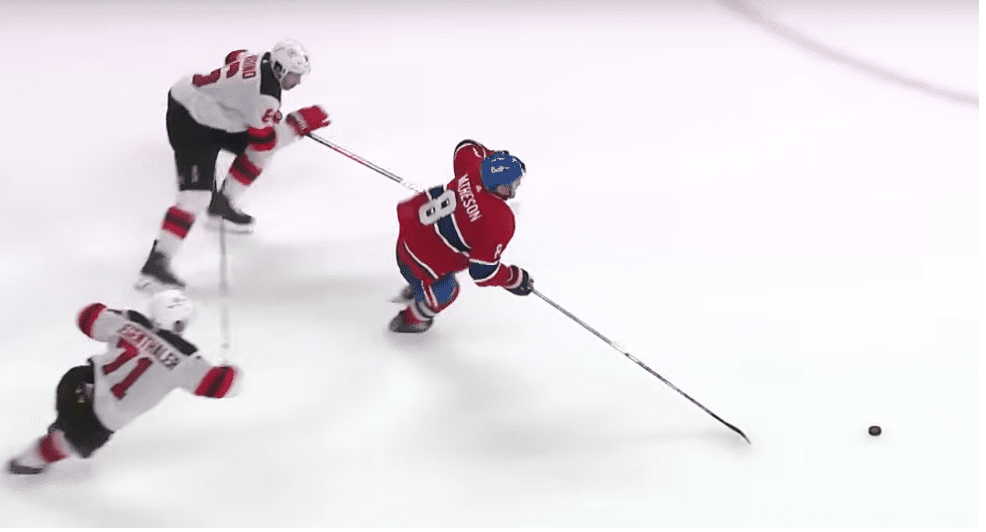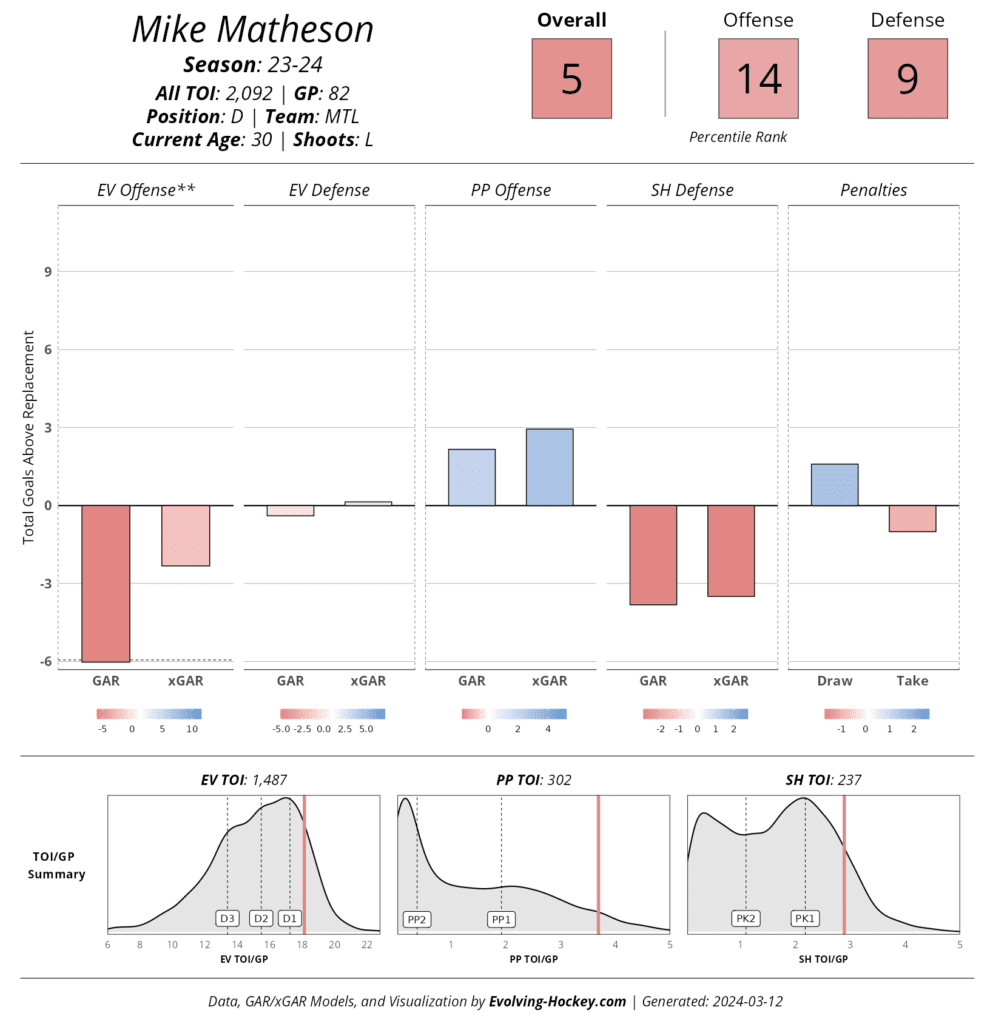Canadiens Analysis
Canadiens Analysis: Mike Matheson’s Impact On The Lineup

(Editor’s Note. This is a special guest post by Montreal Canadiens analyst Andrew Berkshire)
Some have suggested Montreal Canadiens defenceman Mike Matheson is actually the player P.K. Subban’s biggest critics suggested he was during his time with the team.
Truth be told, that’s not really a bad thing, but it is a big reason why he’s facing so much criticism this season.
One of the most polarizing positions in hockey is that of an offensive defenceman.
If you’re the last man back, and your job is to make things happen to move the puck up the ice, when you make a mistake, it’s going to loom larger than a winger bobbling the puck at the offensive blue line.
Combine that with the fact that Matheson has been the Canadiens’ number one defenceman for two years now, playing 25:04 per game; the seventh-highest average ice time in the NHL over that time, and you’ve got a recipe for undue criticism.
However, Matheson is obviously not without his faults.
When you take a look at Matheson’s player card from Evolving Hockey, it becomes clear that not everything is going his way this year.
Making Sense Of The Numbers
At a glance, the data in that player card looks disastrous, but this kind of information is a starting point in our analysis, not the endpoint.
So why exactly is a player who plays 25 minutes per night, who often looks dynamic, who is having a career year offensively on pace for 59 points, a fifth percentile player in goals above replacement in the NHL?
Goals above replacement is a model that attempts to combine a bunch of data to measure the impact of a player, relative to fringe NHL players at that position. Essentially, how many goals plus or minus does a player contribute to the team over what an AHL call-up would?
Being a fifth percentile player means that 95 percent of your peer group is having a better impact on the game than you are, and frankly watching Mike Matheson night in and out, I think we all know he’s not even close to that bad, so what’s going on here?
For starters, let’s look at the good stuff.
Matheson has had a very positive impact on the powerplay. He fits in very well with that top unit of Nick Suzuki, Juraj Slafkovsky, Cole Caufield, and Alex Newhook.
Yes, he does at times look off Slafkovsky as a passing option, but I believe it has more to do with simple-handedness than it does with anything between the players, as fans at times assume. It’s much easier for Matheson to send a quick pass to Suzuki on the left side than pass across his body to Slafkovsky.
It should be noted Matheson has done a much better job identifying Slafkovsky as a shooting option on the powerplay now that Sean Monahan has been traded to the Winnipeg Jets.
Juraj Slafkovsky gives the Habs a 2-0 lead with a nice shot on the powerplay. pic.twitter.com/qcAH9VeL7L
— Marc Dumont (@MarcPDumont) March 12, 2024
Matheson’s bullet of a shot, elite skating, and strong anticipation make him a good decoy to open up shooting lanes for other players, and he is incredibly skilled at holding the blue line, especially on broken plays.
Those keep-ins allow the powerplay to take its time and not have to worry about gaining the zone as often, even if he isn’t personally creating as many high-end passes. His role is as a support player on the powerplay, and a trigger man if nothing else is working, to keep penalty killers honest.
His offensive contributions aren’t perfect, of course.
There’s the good; his anticipation for where to be to take part in the offence is, in my opinion, among the best in the league for defencemen.
And there’s the bad; his next touch after receiving the puck is often not the best decision, which I do think holds him back quite a bit at even strength, but doesn’t hurt him as much on the powerplay at 5-vs-4, because of his role as a support for the big movers on the unit.
Matheson also draws a lot of penalties for a defenceman. With 19 minors drawn from the opposition, Matheson is tied for fourth in the NHL among defencemen, however, he also takes a lot of minors with 26, which puts his -7 penalty differential at a tie for 134th among 203 defencemen to play 500+ minutes this year.
He plays an absolute ton on special teams, but his results on the penalty kill are poor, which is hard to isolate as his issue since the Canadiens’ penalty kill has been a mess all season anyway.
5v5 Impact On Canadiens Lineup
Aside from the penalty kill, we can see that Matheson’s even-strength play looks pretty rough. His defensive play is fine, with his expected performance being above replacement in very tough minutes, but his offence has been terrible.
That doesn’t match the eye test at all when you think of Matheson, so let’s dig in further once more.
Mike Matheson attracts all the attention with his great skating, setting up Sean Monahan to put the Habs up 3-0. #GoHabsGo pic.twitter.com/PECAb8OgQw
— Marc Dumont (@MarcPDumont) January 26, 2024
While Matheson is 10th in the NHL in points among defencemen, he ranks tied for 47th among defencemen at even strength with 18 points, and his 0.93 points per 60 minutes in that game state ranks 109th.
Those aren’t great numbers, but they aren’t abysmal, however, 50 percent of those points are secondary assists, which count for less in models because they’re less repeatable than goals or primary assists.
Per 60 minutes played at 5-vs-5, while Matheson is on the ice the Canadiens produce less offence than when he’s on the bench this season, which is hard to fathom given his skills. Only Jayden Struble has a lower on-ice expected goals for mark than Matheson’s 2.46 per hour, and his actual goals for per hour is a dismal 1.74, ahead of only Christian Dvorak and Brendan Gallagher.
Any time your actual goals for are lower than expected, there’s usually a finishing issue, and the Canadiens are only scoring on 6.41 percent of their shots while Matheson is on the ice, compared to their season-long 8.39 percent overall at 5-vs-5, so there’s absolutely an element of bad luck at play.
However, I do think there’s a bigger issue, and it circles back to the comparison to Subban.
When Subban was in his prime, the general thought was that he was a very risky player. Despite that narrative, he was empirically one of the best defensive players in the league over that time, both in terms of individual actions and team results.
Eric Engels from Sportsnet rightly pointed out that Matheson similarly has some strong individual defensive markers from data tracking companies like Sportlogiq, but he used per-game metrics instead of pro-rated per 60 minutes, which obscures the data because Matheson plays so much.
Regardless, Matheson boasts a very low turnover rate, despite being amongst the league leaders in actual turnovers, because he has the puck a lot. He possesses a lot of individual skills that allow him to defend well too.
He’s an exceptional skater, and very good at stick checking, but there’s also a reason why Matheson leads the league in stick checks per game; he’s defending a lot, and often against the opponents’ best players.
If you break down Matheson’s even strength results by who he plays with, an interesting trend emerges. With the top line of Suzuki, Caufield, and Slafkovsky, the offence drops considerably from 3.09 goals per 60 minutes at 5-vs-5 without Matheson on the ice, to 1.82 goals per 60 minutes.
Why?
Well, when does the coaching staff tend to unite the top line with Matheson? Most often, it’s when they’re worried about a high-end line on the opponent’s team.
Perception Versus Reality
What I notice in those situations is that Matheson tries to push the envelope too much, and gets caught, forcing more time in his own zone, but even still, that four-man unit has an expected goals share of 52.7 percent.
What’s interesting is that Matheson does have a good defensive impact on most of his teammates, but because the offence hasn’t been there at even strength, and because he makes a lot of risky plays to make offence happen, there’s a perception that he’s a big defensive anchor that I don’t believe bears out in reality.
That being said, I do think it’s very clear that while Matheson is capable of playing 25 minutes per night from a fitness point of view, his game does suffer from trying to do too much, and frankly in terms of results, I think fans have picked up on the fact that Kaiden Guhle is probably Montreal’s best defenceman overall.
There’s a pretty simple solution here to help Matheson excel and also make the Canadiens better.
It’s splitting up Guhle and Matheson.
Matheson should be holding down the second pair at even strength, while Guhle takes the toughest minutes with a stable partner like Johnathan Kovacevic.
Slot Matheson into the role he’s better suited to, and reduce his penalty-killing minutes because it’s not a strength anyway.
Matheson is a very good hockey player, anyone with eyeballs could tell you that, but the combination of being overburdened in terms of responsibility and bad shooting luck while he’s on the ice has created friction where there doesn’t need to be.
He can still absorb heavy minutes, and surprisingly his results were better with David Savard than with Guhle anyway.
I’m sure the Canadiens are hesitant to call a 22-year-old defenceman their number one guy, but until someone like David Reinbacher or Lane Hutson blossoms and takes over, on the defensive side of the ice, this is Guhle’s team now, and that’s better for Matheson too.










